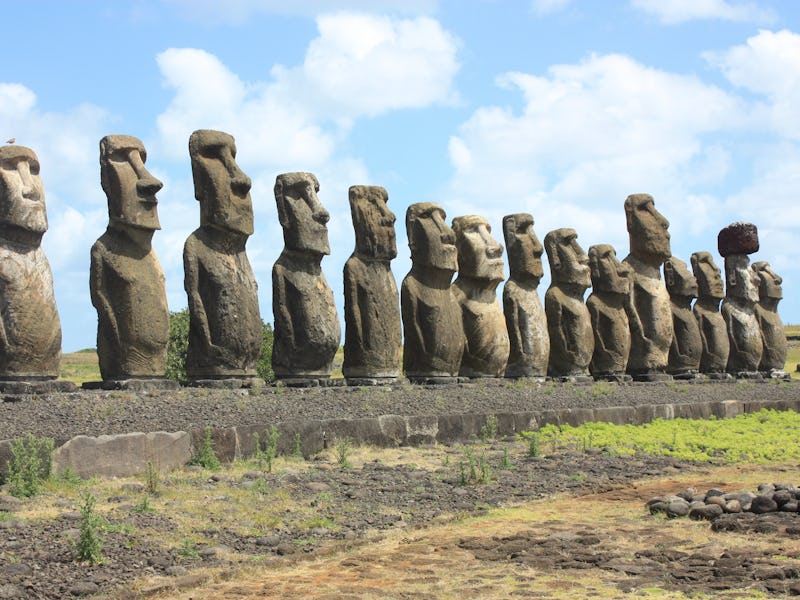Easter Island's Giant Stone Hats Are Rewriting Its Mysterious History
Perhaps its inhabitants were not warriors after all.

Modern researchers have long suspected that the inhabitants of Rapa Nui — known to English-speakers as Easter Island, home of the giant carved monoliths — lived in warrior societies that were constantly engaged in violence. New research on giant stone hats, once worn by the famous statues, provides evidence that this view may be incomplete, suggesting that in fact Rapa Nui was home to a much more cooperative bunch of folks.
In a paper published in the October issue of Advances in Archaeological Progress, archaeologists examined the previously under-studied 70-ton stone hats — called pukao — that once adorned the heads of Rapa Nui’s iconic maoi statues, finding evidence of detailed inscriptions that had never been seen before using digital imaging techniques.
These cylindrical hats, which weigh several tons, are made from red volcanic rock called scoria, and while the scientists had known these hats were once placed on top of the statues by the inhabitants of Rapa Nui to honor their ancestors, their significance wasn’t entirely clear.
These massive stone hats once adorned Rapa Nui's iconic stone statues. Recent examination revealed never-before-seen petroglyphs.
The practice, however, fits in with what researchers know about the traditions of other Polynesian societies and how they venerated their ancestors. As the study suggests, the process of erecting these giant stone statues and placing hats on them required the warring peoples of Rapa Nui to put down their weapons and work together — at least for a little while.
Using a low-cost 3-D imaging technique called structure-from-motion mapping, which overlaps many redundant images of an object or area, the researchers revealed petroglyphs in the surface of the pukao that modern researchers had never seen before.
The petroglyphs indicated that the people of Rapa Nui were not, as has been hypothesized, a loose collection of warring groups. The varying ages and designs of the maoi suggest that, even as the groups lived separately, they periodically cooperated. These observations led the researchers to conclude that the island’s mysterious inhabitants were, in fact, a network of communities who regularly came together to build monumental statues that honored their predecessors.
Rapa Nui's iconic maois required the cooperation of multiple groups, say archaeologists.
“With the building mitigating any sense of conflict, the moai construction and pukao placement were key parts to the success of the island,” said Carl Lipo, anthropology professor and director of the Environmental Studies Program at Binghamton University, one of the authors on the paper, in a statement.
“In our analysis of the archaeological records, we see evidence that demonstrates the prehistoric communities repeatedly worked together to build monuments. The action of cooperation had a benefit to the community by enabling sharing of information and resources.”
Rapa Nui is about 2,000 miles off the coast of Chile in the southeastern Pacific.
While the findings of this study temper the violent stereotypes long associated with the people of Rapa Nui, there’s still plenty scientists have yet to learn about them — and how their community came to an end. Researchers know that the population of Rapa Nui experienced a rapid decline at some point in its history, but they aren’t sure why. Archaeologists, however, have identified some suspects: overpopulation, warfare, and a sudden influx of invasive rats.